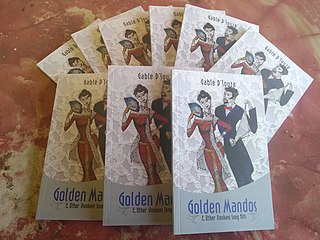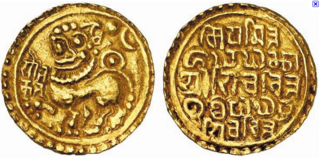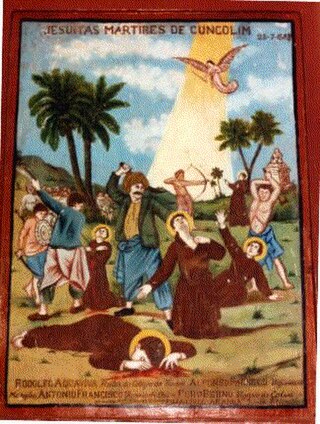
The history of Goa dates back to prehistoric times, though the present-day state of Goa was only established as recently as 1987. In spite of being India's smallest state by area, Goa's history is both long and diverse. It shares a lot of similarities with Indian history, especially with regard to colonial influences and a multi-cultural aesthetic.

Margao is the commercial capital of the Indian state of Goa. It stands on the banks of the Sal river and is the administrative headquarters of Salcete sub-district and South Goa district. It is Goa's second largest city by population after Vasco.

Music of Goa refers to music from the state of Goa, on the west coast of India. A wide variety of music genres are used in Goa ranging from Western art music to Indian classical music. Konkani music is also popular across this tiny state. Being a former territory of Portugal, Goa has a dominant western musical scene with the use of instrument such as the violin, drums, guitar, trumpet and piano. It has also produced a number of prominent musicians and singers for the world of Indian music. Portuguese Fado also has significance in Goa.

Salcete is a subdivision of the district of South Goa, in the state of Goa, situated by the west coast of India. The Sal River and its backwaters dominate the landscape of Salcete. Historically, the sixty-six settlements south of the Zuari River formed the original Salcette territory. Salcete forms a part of the bigger Konkan region that stretches along the western shoreline of peninsular India.

The Goa Inquisition was an extension of the Portuguese Inquisition in Portuguese India. Its objective was to enforce Catholic orthodoxy and allegiance to the Holy See. Conversions took place through the Goan Inquisition with the persecution of Hindus and the destruction of Hindu temples.
Goa is a state of India. Goans are commonly said to be born with music and football in their blood because both are deeply entrenched in Goan culture.
Goan Catholics are an ethno-religious community of Indian Christians adhering to the Latin Rite of the Catholic Church from the Goa state, in the southern part of the Konkan region along the west coast of India. They are Konkani people and speak the Konkani language.
Goans is the demonym used to describe the people native to Goa, India, who form an ethno-linguistic group resulting from the assimilation of Indo-Aryan, Dravidian, Indo-Portuguese, Austro-Asiatic ethnic and/or linguistic ancestries. They speak different dialects of the Konkani language, collectively known as Goan Konkani. "Goanese", although sometimes used, is an incorrect term for Goans.

The Saptakoteshwar temple at Narve in Goa, India, is considered to be one of the six great sites of temples of Shiva in the Konkan area.

The state of Goa, in India, is famous for its beaches and places of worship. Tourism is its primary industry, and is generally focused on the coastal areas of Goa, with decreased tourist activity inland.

The Kadambas of Goa were a dynasty during the Late Classical period on the Indian subcontinent, who ruled Goa from the 10th to the 14th century CE. They took over the territories of the Shilaharas and ruled them at first from Chandor, later making Gopakapattana their capital.

Velim, formerly Velliapura, is a large village situated in Salcete, neighbouring Quepem taluka and falls under South Goa district, in the Indian coastal state of Goa. It has access to the Arabian Sea via the Sal river that flows through it and shares its borders with neighbouring villages/cities of Assolna, Ambelim, and Cuncolim. The village consists of 22 hamlets or subdivisions that have been put together into 9 wards. As of 2020, the village has a total population of about 8600 residents residing in 2568 households. It is also a part of Velim Assembly constituency.
Chandor is a village in Salcete sub-district of South Goa, in the Indian state of Goa. It lies on the southern bank of the Zuari River and western bank of the Kushavati River.

Tristão de Bragança Cunha, alternatively spelled as Tristao de Braganza Cunha, popularly known as T B Cunha was a prominent Goan nationalist and anti-colonial activist from Goa. He is popularly known as the "Father of Goan nationalism", and was the organiser of the first movement to end Portuguese rule in Goa.

Roman Catholic Kshatriyas are a modern Christianised caste among Goan, Bombay East Indian, Mangalorean, Kudali & Karwari Catholics. They are patrilineal descendants of Kshatriya and Vaishya Vani converts to the Latin Church, in parts of the Konkan region that were under Portuguese Goan rule. They are known as Chardo in Goan Konkani, Charodi in Canarese Konkani & as Sandori or Vadval in Damanese and Mahraashtrian Konknni, while others also identify as Bhandari or Khatri in their Bombay East Indian dialects.

Luís de Menezes Bragança, alternatively spelled as Luís de Menezes Braganza, was a prominent Goan journalist, writer, politician and anti-colonial activist. He was one of the few Goan aristocrats who actively opposed the Portuguese colonisation of Goa. During his lifetime, Menezes Bragança was widely hailed around the Lusosphere as "O Maior de todos" and in the Indian mainland as "The Tilak of Goa".

The Goan Muslims are a minority community who follow Islam in the Indian coastal state of Goa, some are also present in the union territory of Damaon, Diu & Silvassa. They are native to Goa, unlike recent Muslim migrants from mainland India and are commonly referred to as Moir by Goans in Goan Konkani. Moir is derived from the Portuguese word Mouro. The Portuguese called them Mouros because they were in contact with the Moors, people of predominantly Muslim Maghreb country, who had conquered and colonised the Iberian peninsula for centuries.

Goa is a state on the southwestern coast of India within the Konkan region, geographically separated from the Deccan highlands by the Western Ghats. It is bound by the Indian states of Maharashtra to the north, and Karnataka to the east and south, with the Arabian Sea in the west. It is India's smallest state by area and fourth-smallest by population. Goa has the highest GDP per capita among all Indian states, two and a half times as high as the GDP per capita of the country as a whole. The Eleventh Finance Commission of India named Goa the best-placed state because of its infrastructure, and India's National Commission on Population rated it as having the best quality of life in India. It is the second-highest ranking among Indian states in the human development index.

Jainism flourished in Goa during the rule of Kadamba dynasty of Karnataka. Broken sculptures of the Jain Tirthankara Suparshvanatha, belonging to the period of the Goan Kadamba ruler Shivachitta Permadi Dev, were discovered in an old Jain temple in Jainkot, Naroa.

Carnival in Goa, also called "Carnaval", "Intruz", "Entrado", or (colloquially) "Viva Carnival" refers to the festival of carnival, in the Indian state of Goa. Though significantly smaller than the well-known Rio Carnival or the Portuguese Carnival of Madeira, the Goa Carnival is the largest in India and one of the few traditional celebrations of the Western Christian holiday in Asia. The current version of the Goa Carnival was modelled after the Rio Carnival by a local musician named Timoteo Fernandes and imposed in 1965 to attract tourists. It has since turned into a major tourist attraction for the small state.















